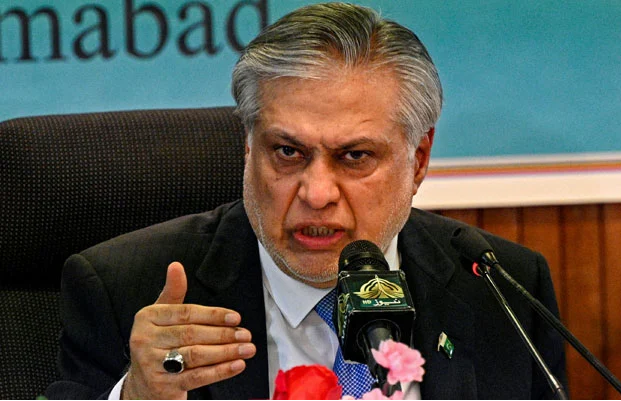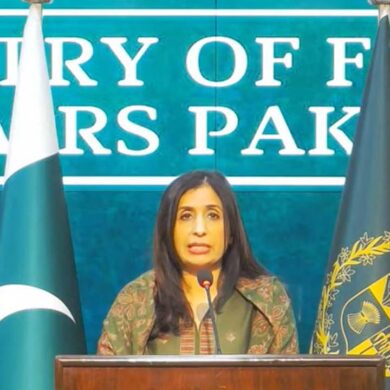Finance Minister Ishaq Dar on Thursday unveiled Pakistan Economic Survey 2022-23 which showed that none of the targets were achieved during the ongoing fiscal year and the growth rate plunged to 0.2 per cent due to political instability, floods and global economic slow down.
Addressing a news conference here, the finance minister acknowledged challenging economic situation and highlighted the government’s focus on areas such as exports, equity, empowerment, environment, and energy.
He lashed out the previous government which inherited the PDM a ruined economy. “I left a strong economy in 2017 as finance minister under the leadership of Nawaz Sharif.”
Dar said his foremost priority was to stabilize economy through improvement in macro economic indicators.
“We followed our ‘three-Es’ concept and Pakistan saw macroeconomic growth,” he said adding we are now focusing on five-Es including exports, equity, empowerment, environment, and energy.”
The finance minister said the government took prudent steps to improve economic situation which was very challenging when the PDM government came into power.
During the discussion on the outgoing fiscal year 2022-203, he highlighted the inclusion of the information and technology sector as a stand-alone category in the economic survey.
According to the minister, this sector held significant potential for future growth. The government’s objective was to attain macroeconomic stability while ensuring inclusivity and resilience.
The finance minister emphasized the importance of inclusivity in order to prevent the unequal distribution of resources.
By achieving this goal, he said the government aimed to restore investor confidence.
The minister stated that creating an inclusive environment would help address concerns about resource allocation and contribute to overall economic stability. The government recognized the significance of the information and technology sector and its potential to drive economic growth in the coming years.
He acknowledged the immense challenges faced by the PML-N-led coalition government upon taking charge in 2022. At that time, he added, the fiscal space had significantly contracted, inflation was escalating, the current account deficit was soaring, and financing requirements were mounting.
The minister pointed out the direct correlation between policy rate hikes and increased financing needs. He expressed his belief that had the current government not assumed power, the consequences could have been dire.
He implied that the government’s intervention was crucial in averting a potentially precarious situation, although the exact outcome remained uncertain.
The finance minister defended his claims by highlighting a significant reduction of $6,400 million in foreign exchange reserves during the last quarter before Shehbaz Sharif’s government assumed power.
He asserted that the country had managed to weather five quarters under challenging circumstances, and he expressed concerns about the potential consequences if the same pace had continued.
The finance minister reassured that the downward spiral of the economy had been halted, and it was now progressing towards stability. He drew attention to the fact that when the current government came into power, the GDP growth rate was 6%, but it should be noted that the previous year had experienced negative growth at -1%. This low base served as a reference point, and he explained that when the base is low, subsequent years establish a new baseline for growth.
Meanwhile, the pre-budget document released by the government showed that Pakistan’s GDP growth rate had slowed down significantly in the ongoing fiscal year.
The country has struggled to meet its annual macroeconomic targets due to various factors including political unrest, catastrophic floods, trade barriers, and a pending International Monetary Fund (IMF) bailout.
During the outgoing fiscal year, the GDP grew by a mere 0.29% due to macroeconomic imbalances, supply shocks, and a global economic slowdown.
The agriculture sector was particularly affected by flash floods, resulting in a decline in cotton and rice production but an increase in sugarcane, maize, and wheat production. The floods caused significant damages, with estimated losses and rehabilitation expenditures amounting to trillions of rupees.
Pakistan’s economy faced domestic shocks in addition to external challenges. The large-scale manufacturing sector experienced a decline in growth, primarily due to flood damages and restrictive policies implemented by the State Bank of Pakistan to address the balance of payment crisis and control inflation.
The fiscal deficit reduced to 4.6% of GDP during July-April FY23, compared to 4.9% in the same period last year. The current account deficit also narrowed down, primarily due to a decline in the merchandise trade deficit.
However, inflation has surged, with headline CPI national inflation averaging 29.2% during Jul-May FY23, mainly driven by a weaker exchange rate, supply disruptions from flood damages, higher global food prices, and tariff reforms.
Total revenues increased by 18.1% in July-March FY23, with both tax and non-tax revenues contributing to the growth. Tax revenues grew by 16.5%, driven by increased FBR tax collection despite economic challenges. Non-tax revenues also saw a significant increase.
The government is taking administrative actions, implementing policy reforms, and introducing relief measures to control the prices of essential items and address inflationary pressures.



